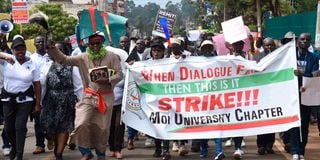Premium
State of the nation: Why there’s little to celebrate in education sector

Lecturers and employees at Moi University demonstrate in Eldoret city on September 27, 2024.
What you need to know:
- Primary schools appear to have fairly navigated the early challenges of CBC.
- The government introduced a new funding model for tertiary education in 2023.
When President William Ruto read his State of The Nation Address on November 9, 2023, the education sector faced various challenges and the situation has since gotten worse for some sub-sectors.
The government has phased out 8-4-4 out of the primary school section but adoption of the competency-based curriculum (CBC) is still far from smooth. The last 8-4-4 class will join Form 2 in January 2025.
Whereas primary schools appear to have fairly navigated the early challenges of CBC, junior school remains the biggest challenge to the Kenya Kwanza administration.
The decision to domicile the section in primary schools followed a recommendation of the Presidential Working Committee on Education Reforms (PWPER).
However, since the pioneer class joined Grade 6 last year, the learners in public schools have been handled by teachers on contract, commonly referred to as interns. Junior schools are grossly understaffed and the teachers are forced to teach subjects they are not specialised in.
In his 2023 address, President Ruto said that the government had employed 56,750 new teachers. What he did not reveal at the moment is that the majority of them were on contract.
To the credit of the government, 46,000 of these teachers have been converted to permanent and pensionable terms. There’s a promise to recruit 20,000 more on contract in December 2024.
While campaigning to be president, Dr Ruto promised in his manifesto to employ 116,000 teachers within the first two years to plug the staffing gaps but he has not succeeded in doing so.
However, junior schools will still remain understaffed. This is schools will get, on average, one new teacher, since there are about 23,000 junior schools.
Parents and other stakeholders in education are eager to see the roll-out of Grade 9 in January 2025. This is an additional class and many schools lack the infrastructure to accommodate the learners.
Questions also abound on the readiness of the learners to transit to senior school the following year where they are expected to select particular pathways according to their interest as well as ability.
In the 2023 State of the Nation Address, Dr Ruto did not speak about the Free Day Secondary Education (FDSE). Government funding for the programme has shrunk from the stipulated Sh22,244 per learner annually to about 15,192 this year.
The underfunding has affected many schools, especially day schools, which depend entirely on government funding. Some schools have been taken to court by suppliers over debts owed while others have resorted to charging parents extra fees to cover the financial gaps.
It is in tertiary education where the Kenya Kwanza government faces the biggest problems. The debt crisis in public universities has only gotten worse over the period.
The government introduced a new funding model for tertiary education in 2023 but it has generally faced rejection by students, parents and other stakeholders. In its second year of implementation, more shortcomings of the model have emerged, forcing President Ruto to form a committee to review the model, when university students threatened a countrywide strike against it.
The committee was supposed to work for eight weeks which have since lapsed but there has been no communication about its work. The funding model was stopped by the courts following a petition by a lobby group and its fate remains unclear.
Further, lecturers in public universities have been on strike for the better part of the first semester demanding better pay and implementation of a collective bargaining agreement (CBA) they signed in 2021 and is meant to conclude in 2025. The semester is drawing to a close but it remains uncertain how the lost time will be recovered.
One project in higher education the government appears to have gotten right is establishment of the Open University of Kenya. The university is based at the Konza Technopolis and in its first year enrolled 3,791 students but short of the projected 7,000.
The government has also not faced serious challenges in the technical and vocational education and training (TVET) sub-sector.
In terms of reforms, the government lags behind in getting various proposed amendments in law passed despite the respective Bills having been drafted.





